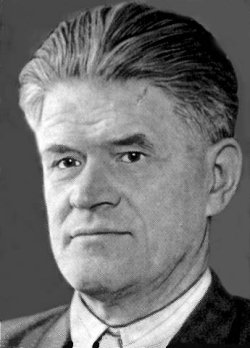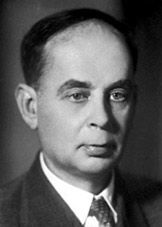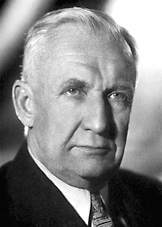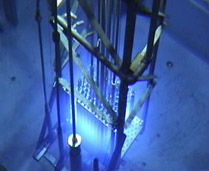Cerenkov, Pavel Alekseevich (1904–1990)

Pavel Cerenkov was a Russian physicist who in 1934, while working at the Institute of Physics of the Soviet Academy of Sciences, discovered that light is emitted by charged particles traveling through media at speeds higher than the speed of light in those media. This type of light is now known as Cerenkov radiation. Cerenkov was awarded the 1958 Nobel Prize in Physics with his co-workers, Ilya M. Frank and Igor Y. Tamm, who provided an explanation for Cerenkov radiation in 1937).
 |
| Ilya Mikhailovich Frank
|
 |
| Igor Yevgenevich Tamm
|
Cerenkov radiation
Cerenkov radiation, also called Cerenkov light, is visible light, with a maximum intensity in the blue spectral region, which is produced by charged particles traveling through a translucent medium at a speed greater than the speed of light in the same medium; it is often seen (as in the illustration here) when radioactive materials are stored under water. Cerenkov radiation The threshold energy for the occurrence of Cerenkov radiation for electron radiation in water (n = 1.33) is 260keV.
 |
High-energy nuclei with a charge greater than or equal to six are capable of producing Cerenkov light. The light observed is frequently attributed to a shock wave phenomenon and has been thought of as an optical analog of the sonic boom; however, this is not entirely correct. What actually happens is that a fast-moving charged particle moving through a dielectric medium causes local, non-isotropic polarizations in the atoms of the dielectric. These atoms return to normal states by emitting light. If the velocity of the particle is less than the velocity of light in the medium, the light is destroyed by destructive interference. If the velocity of the particle is greater than the velocity of light in the medium, the light remains due to constructive interference.
The phenomenon was discovered by Mallet in 1926 and studied by Cerenkov from 1934 to 1938. Cerenkov proved that it was not a fluorescence effect and found that the light was partially polarized. A correct theoretical explanation for Cerenkov radiation was first given by Frank and Tamm in 1937.
Cerenkov counter
Cerenkov radiation is used in a Cerenkov counter – a device that identifies particles passing through it by observing a flash of light generated in a manner similar to a sonic boom.


